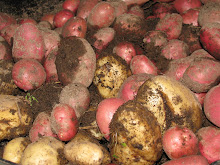Many in the ag industry are using Twitter and blogs to communicate, educate.
Published online on Sunday, Oct. 11, 2009
By Robert Rodriguez / The Fresno Bee
With a hand-held video camera, a computer and 800 cows, Barbara Martin of Lemoore is letting the world into her life as a dairy operator.
No, it's not a new reality television show. And Martin isn't craving her 15 minutes of fame.
But she is joining a growing number of farmers and others in agriculture who are using social media tools to communicate with each other, send out information and educate the public about agriculture.
Dairy operators have become especially skilled at launching Facebook pages, blog posting and using Twitter, a microblogging site.
Martin uses all three to tell the public about the family's 800-cow dairy. She launched her blog, "A Dairy Goddess's Blog," in late August.
When Barbara Martin shoots a video for her blog where she is known as Dairy Goddess, she just goes out and finds her favorite cow, Chica, holds the camera and narrates what is on her mind. She uses social networking tools such as Twitter and Facebook to connect with dairy people across the U.S.
For Martin, using social media and blogging is a way to dispel some myths about farmers and encourage a greater understanding of the slumping dairy industry.
She's blogged about everything from fixing the pricing structure for milk to sharing her childhood memories about growing up on a farm. Her most recent post is a video diary about her heifer Chica.
Martin and other dairy operators say their critics such as People for the Ethical Treatment of Animals have used the Internet's power to portray them as cruel, greedy and corporate.
PETA has posted videos on its Web site showing animals being neglected on a Pennsylvania dairy.
"I want people to know about the people and families who run dairies in this country," said Martin, a third-generation dairy operator. "This is not a factory farm. We are a family who cares about their animals, and I want to show that."
Cindy Zimmerman, who co-owns a Missouri-based new media company with her husband, Chuck, said much of what's driving farmers to use Twitter, Facebook and even YouTube is the desire to raise the public's awareness about agriculture.
She said many consumers still don't understand the role farming plays in the economy and the challenges farmers face, including weather, pests and low prices.
"These new tools have become a way for the individual farmer to get their story out to the public," Zimmerman said. "And for some, this has become a way to connect with people that they never would have been able to do before."
Although it may be too early to tell whether Twittering farmers are changing public opinion, the effort to use social media shows no signs of slowing.
Among those who use social media is motivational speaker and new-media adviser Michele Payn-Knoper.
More than 2,000 people follow her posts on Twitter.
Payn-Knoper of Indiana hosts a session on Twitter called AgChat every Tuesday from 5 to 7 p.m., and she averages 100 to 200 participants. She's had as many as 500 people participating.
"Social media has become such an incredible information platform for farmers and agriculture," Payn-Knoper said. "And many are seizing that opportunity."
Payn-Knoper said more dairy operators are joining Twitter and Facebook largely because the industry has sponsored seminars on the topic. Other agricultural industries have been slower to latch onto the new technology.
Bob McKellar of Ivanhoe is a newcomer to Twitter. McKellar's Family Farm Fresh uses the site to promote its community-supported agriculture operation.
The farm delivers fresh fruits and vegetables to people who sign up and subscribe. Its Twitter site updates customers with the latest offerings or asks people whether they prefer plums soft or crunchy.
McKellar, a farmer for more than 30 years, admits he doesn't know how to use Twitter, but he fully understands its potential. One of his employees does the Twitter posts.
"I have a computer and a cell phone, and to be honest with you I know very little about either one of them," McKellar said. "But what I do know is that these new ways can help reach people like we haven't been able to do before."
University of California cooperative extension specialist Matthew Fidelibus uses Twitter and Facebook to share his research on grapes with farmers.
State budget cuts have made it tougher for some UC farm advisers to reach growers through field meetings or personal visits to farms. To reach more farmers, Fidelibus has posted Twitter updates on how to deal with a recurring problem of powdery mildew, a fungal disease common among vineyards.
And while Fidelibus has become a regular on Twitter, his raisin farmer clients haven't quite caught up.
"The demographic of the raisin farmers we deal with is skewed more toward older growers, so we are not sure if they use this sort of technology or not," Fidelibus said. "But if we can dispel some of the myths about using Facebook and Twitter, then the potential to reach people could be huge."
Sunday, October 18, 2009
Subscribe to:
Post Comments (Atom)

No comments:
Post a Comment